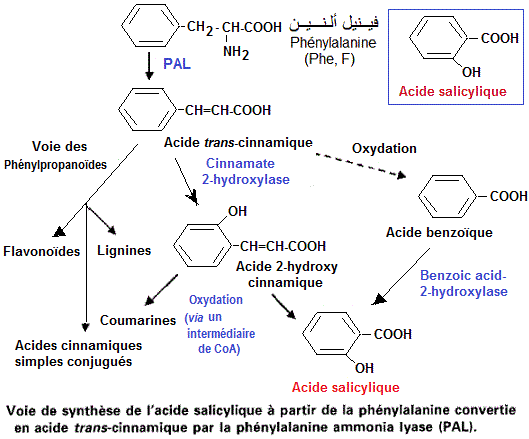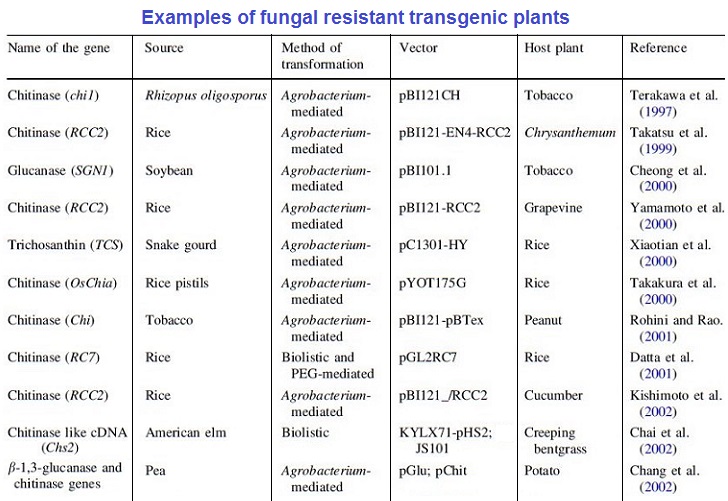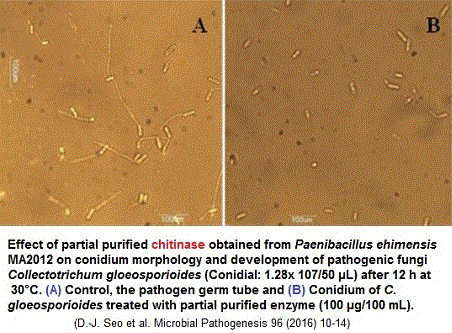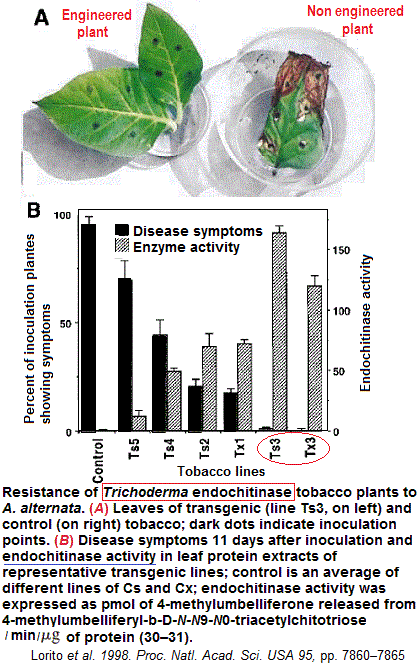Plant resistance against pathogens. Strategies for the production of engineered plants resistant against fungi (resistant engineered plants) can be achieved through the production of transgenic plants with antifungal molecules like proteins and toxins, ...
Master commun: Microbiologie appliquée-Gestion et valorisation des phytoressources, Module 'Phytopathologie et méthodes de lutte'
Strategies for the production of fungus resistant transgenic plants can be basically classified into two categories:
1/ Production of transgenic plants with antifungal molecules like proteins and toxins (like phytoalexins).
2/ Induction of a hypersensitive response through R genes or by manipulating genes of the systemic acquired resistance (SAR) pathway.

1/ Production of engineered plants with antifungal molecules like proteins and toxins (like phytoalexins).
Some of these proteins are: Pathogenesis-related proteins, Ribosome-inactivating proteins, Small cystein-rich proteins, Lipid transfer proteins, Storage albumins, Polygalacturonase inhibitor proteins (PGIPS), Antiviral proteins, and Non-plant antifungal proteins.
--
Pathogenesis-related proteins (PR proteins) as example:
PR proteins were shown to be induced not only by pathogens but also by wounding, fungal cell wall elicitors, ethylene, UV light, heavy metals, etc. PR proteins are induced during hypersensitive response (HR) and also during systemic acquired resistance (SAR) and therefore are thought to have a role in natural defense or resistance of plants
against pathogens. PR proteins have been grouped into five families
based on primary structure, serological relatedness and enzymatic
and biological activities. Members of all the five PR families (PR-1
to PR-5) have been shown to have antifungal activity
---- Family of PR-1 proteins consists
of low molecular weight (15–17 kDa) proteins. Their biological
function is not known, nevertheless, constitutive expression of
PR1A gene in tobacco enhances resistance of the plant to Peronospora
tabacina12.
---- PR2 and PR3
type proteins are the fungal cell wall hydrolysing enzymes, glucanase
and chitinase, respectively. These proteins can inhibit the fungal growth in vitro by causing lysis of hyphal tips.
---- Proteins of PR4 families are
also low molecular weight and similar to potato win proteins. They
show in vitro antifungal activity particularly in combination
with other antifungal proteins.
----
PR5 proteins (thaumatin-like
or AP24 or osmotin), in all probability, cause lysis of the pathogen
by permeabilizing the fungal cell wall.
Transgenic plants expressing more than one PR protein genes in a constitutive manner were developed . Such transgenics showed better resistance levels than transgenics having a single gene.

-- Phytoalexins as an example of metabolites.
Phytoalexins
are antimicrobial low molecular weight secondary metabolites produced
in plants following pathogen attack and are believed to have a role in
plant defense. Biosynthesis of phytoalexins is often complex involving
many pathways and hence, several substrates and enzymes. Nevertheless,
there has been success in developing transgenics which synthesize new
phytoalexins by simply introducing the gene for the last enzyme of the
pathway.
Example: introduction of the gene encoding stilbene synthase in a host plant. The expression of stilbene synthase (or resveratrol synthase) gene results in the production of resveratrol, a stilbene-type phytoalexin. Such transgenics showed
enhanced resistance to many fungi. Transcription promoters are used On
utilise des transcription promoters.

For example, a
bean vacuolar chitinase gene under thecontrol of the strong constitutive promoter from t he cauliflower mosaic virus (CaMV)35S was transferred to tobacco and Brassica napus.
Instead of using a constitutive promoter such as 35S to ensure the expression of chitinase genes in the transgenic plants, it is possible to use tissue specific promoter to direct the location of the chitinase gene expression. Since roots are the organ of the plant that are most subject to pathogen attack, it would be very beneficial to over-express chitinase specifically in roots via a root-specific promoter.
2/ Production of transgenic plants for hypersensitive response
Genes encoding antifungal proteins provide resistance to only a limited level and to only a limited number of fungi. For example, over-expressing the chitinase gene did not provide resistance against fungi lacking chitin. Moreover, a fungus can modify its cell wall by biosynthesis of more chitosan or glucan in place of chitin and, therefore, may become pathogenic again or it can evolve mechanisms to detoxify certain phytoalexins.
During
the last decade more than 30 resistance genes
which confer resistance against a wide range of pathogens, including viruses,
bacteria, fungi, nematode and even aphids have been cloned from both monocots
and dicots. Interestingly, different resistance genes are highly homologous
to each other and their products are remarkably similar. All the R proteins
contain leucine-rich repeat (LRR) domain, with only one exception
of R protein of tomato, potato..
Other approaches to induce cell death.
One of the earliest events in incompatible plant pathogen interaction is oxidative burst during which active oxygen species such as H2O2 are produced. H2O2 triggers production of phytoalexins, PR proteins and other HR related processes.

H2O2 also has a direct inhibitory effect on microbial growth. Glucose oxidase (GO), an enzyme occurring in some bacteria and fungi, brings about the oxidation of b-D-glucose, yielding gluconic acid and H2O2. GO has not been found in animals and plants. Expressing a GO gene from a fungus Aspergillus niger in potato showed increased level of H2O2. Such transgenics had reduced susceptibility to Erwinia carotovora subspecies carotovora (bacterium), Phytophtora infestans (fungus, mildew) and Verticillim dahliae (fungus).




Engineered plants with overexpression of peroxidase
A high level of constitutive peroxidase expression (as well as other defence-related enzymes) in a hybrid between Nicotiana glutmosu/N debneyi was found to be associated with resistance to a number of tobacco pathogens including Phytophthora parasitica var nicotiana. High levels of peroxidase activity has been used as a marker for resistance to downy mildew in muskmelon. Peroxidase enzymes can generate toxic radicals which are inhibitory to the growth of fungal pathogens in vitro.
Engineered plants with overexpression of chitinase. Towards biocontrol strategies
The plant defense system against microbial pathogens may be modified to produce high constitutive levels of antimicrobial compounds. Plant genes encoding cell wall degrading enzymes, especially chitinases, have been used to alter plant resistance to fungal pathogens, but no single genes have produced an adequate level of resistance, and almost no papers report resistance to multiple pathogens. Reasons for this may be that plant chitinases: (i) usually affect only the hyphal tip and are unable to effectively degrade harder chitin structures, (ii) have weak antifungal activity alone, (iii) are inhibitory only to a limited number of fungal species, and (iv) have no effect on several important pathogens.
Bacteria against fungi. An example of biocontrol strategy

In
terms of antifungal activity, chitinase genes from biocontrol
fungi such as Trichoderma are clearly an improvement
over corresponding plant genes. These
fungal genes encode for chitinolytic enzymes that can reach
the antifungal activity level of some chemical fungicides. Furthermore,
extensive testing in vitro has shown that there are virtually
no chitinous pathogens resistant to Trichoderma chitinases.
Trichoderma spp. are fungi that are present in nearly all
soils and other diverse habitats. Endochitinase gene of Trichoderma
harzianum was transferred to tobacco and potato. High expression
levels of the fungal gene were obtained in different plant tissues.
Resistance to the foliar pathogens Alternaria alternata,
A. solani, Botrytis cinerea, and the soilborne pathogen Rhizoctonia solani
was tested. Therefore, it is expected that the engineered use of these enzymes should produce
a high level of resistance in crop plants against a variety of fungal
pathogens and, in contrast to plant genes, could be accomplished
with a single fungal gene (Genes from mycoparasitic fungi as a source for improving plant resistance to fungal pathogens. Lorito et al. Proc. Natl. Acad. Sci. USA 95 , 1998).
Fungi against fungi. An example of biocontrol strategy

- Plant resistance against pathogens. Contents
- Fungal diseases
- Passive
defenses
- Active defenses
- Chitinase example
- Peroxidase example
- QCM Résistances des plantes aux pathogènes
Exams:
- Master exam June 10, 2016 (chitinase)
- Contrôle
S6 sur transformation génétique du tabac et de la pomme de terre par le gène de la chitinase de Trichoderma harzianum
Biotech-ecolo. net. SUPPORTS
CHAINE YOUTUBE
Chaine Youtube (abonnement). Plusieurs vidéos multilingues (+ s/titres) aux sujets des Biotechnologies et Biochimie
- Annonces de Cours
- Annonces de Workshops